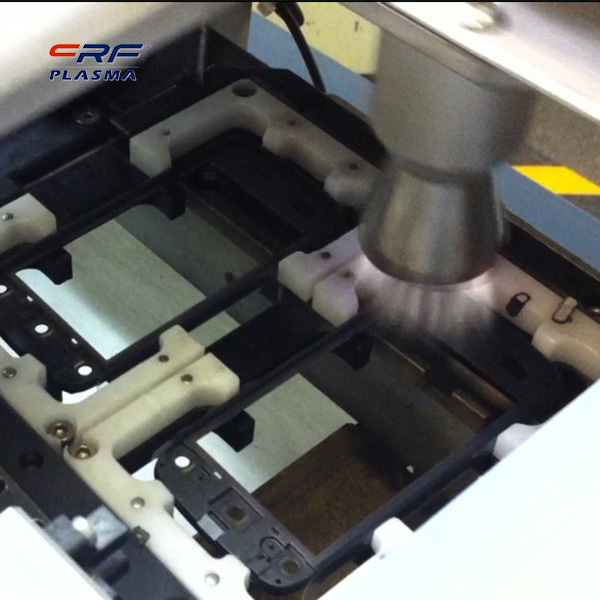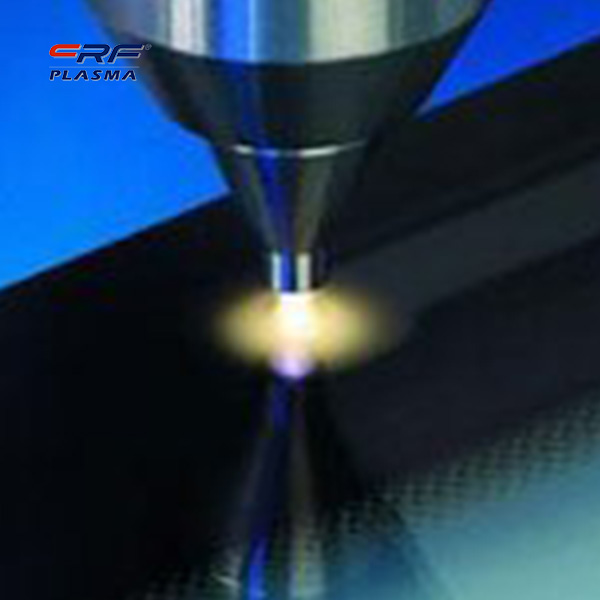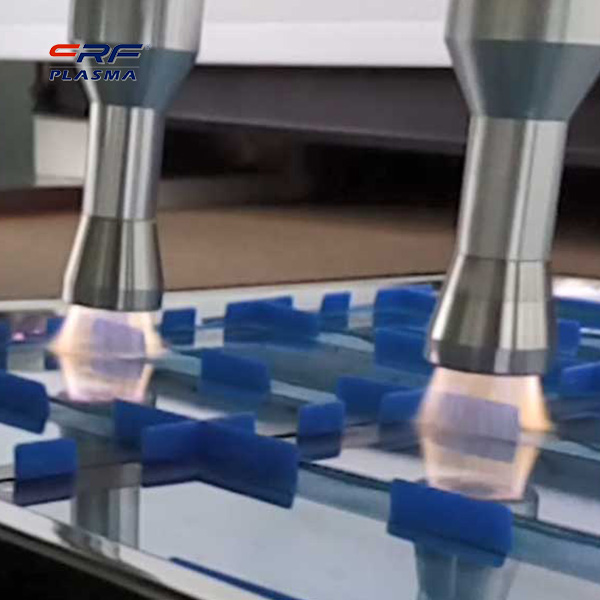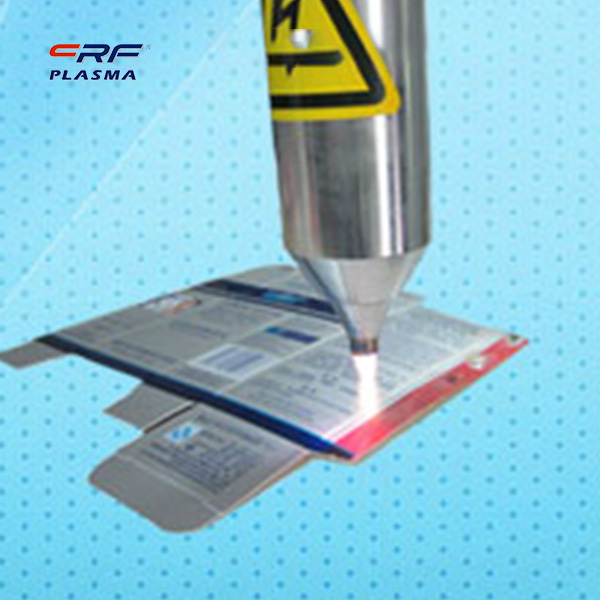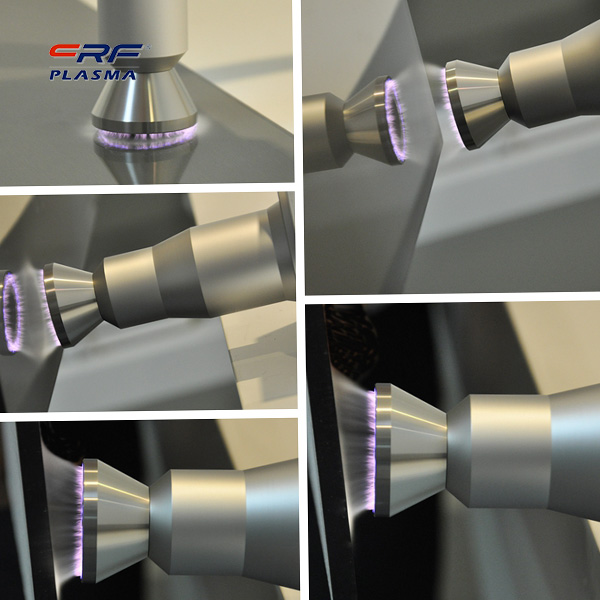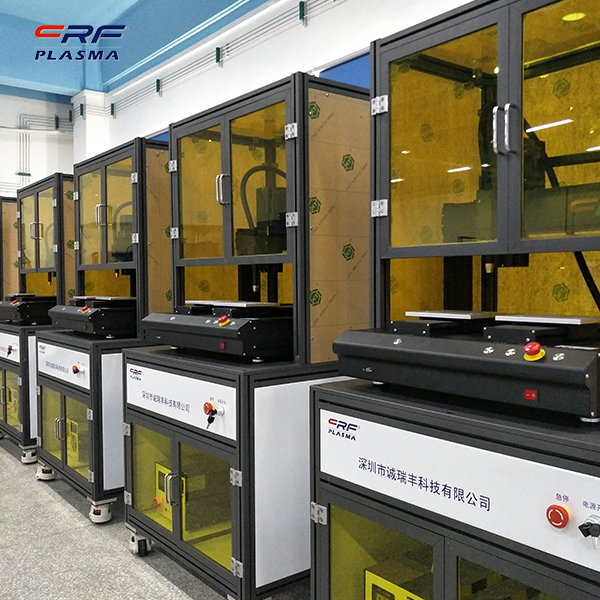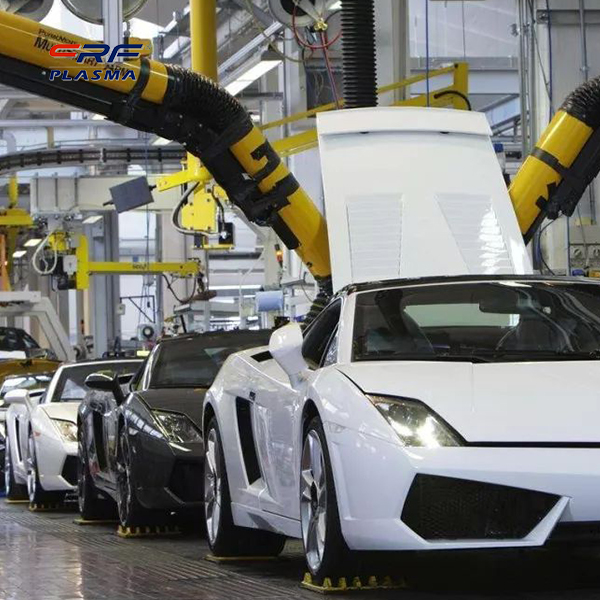
Welcome to Shenzhen Sing Fung Intelligent Manufacturing Co., Ltd.
E-mail:shaobo@sfi-crf.com
The effect of low-temperature plasma surface treatment on the inter-turn insulation performance of variable frequency traction motors
- Categories:Technical Support
- Author:Plasma cleaning machine-CRF plasma plasma equipment-plasma surface treatment machine manufacturer-chengfeng intelligent manufacturing
- Origin:
- Time of issue:2021-09-27
- Views:
(Summary description)The effect of low-temperature plasma surface treatment on the inter-turn insulation performance of variable frequency traction motors: Polyimide (PI) is used in the turn-to-turn insulation of traction motors of high-speed EMUs due to its excellent dielectric properties. China's high-speed railways have achieved world-renowned achievements through the introduction, digestion, absorption and re-innovation. The frequency conversion traction motor is one of the core equipment of high-speed EMUs. Its speed adjustment is carried out through pulse width modulation (PWM) technology. Due to the short rise time and high frequency of the pulse, the cable and motor terminal Impedance detuning will generate overvoltage, which will impact the inter-turn insulation of the motor, causing its insulation failure and threatening driving safety. Polyimide (PI) is used as the inter-turn insulation material of the variable frequency motor, which uses a 2/3 stacking method to wind the magnet wire, that is, there are three layers of PI film on the magnet wire as the inter-turn insulation of the motor winding. In the process of material preparation, magnet wire winding, etc., defects such as air gaps and wrinkles will inevitably occur between the inter-turn insulating materials of the frequency conversion motor. Studies have shown that the partial discharge in the insulation between the turns of the variable frequency motor is the root cause of the insulation failure of the motor. Therefore, the low-temperature plasma surface treatment can improve the partial discharge resistance of the inter-turn insulation of the inverter motor, which can significantly increase the insulation life of the motor and ensure the safe operation of electric locomotives. In recent years, low-temperature plasma surface treatment technology has been widely used in surface modification of polymer materials. Because of its simple structure and the ability to generate large-scale low-temperature plasma in atmospheric air, it is widely used in industrial production. Low-temperature plasma treatment can cause etching, cross-linking, and group introduction on the surface of the material, thereby significantly changing the surface characteristics of the material, such as hydrophilicity, hydrophobicity, flashover voltage along the surface, surface charge dissipation, space charge accumulation characteristics, etc. . The partial discharge between the insulation of the inverter motor is also a kind of gas discharge that occurs on the surface of the material in the air gap, and its working voltage is a square wave pulse voltage. Increase the intensity of the discharge in the air gap. Therefore, low-temperature plasma surface treatment can be used to only change the surface of the material without affecting the superior characteristics of its internal matrix structure. Plasma surface modification of the polyimide film can be used to improve its insulation performance. The contact angle is a key parameter reflecting the surface energy of the film, which is determined by the surface characteristics of the film. The smaller the contact angle, the stronger the hydrophilicity of the film surface and the greater the surface energy. The modification of materials by plasma is actually a process of interaction between the plasma and the surface of the material. In this process, the etching of the surface of the material, the cross-linking of molecular chains, and the introduction of polar functional groups mainly occur. The highly active plasma ionizes or excites many molecules in the air (such as H2O, 02, N2, etc.) and forms particle products (N2, O2, O, H, ultraviolet light, etc.), which are processed in the plasma During the process, it will bring higher energy and hit the PI film. On the one hand, the PI film will be cross-linked or etched, so that the inert substances in the amorphous area on the surface are eliminated and the active groups are exposed. On the other hand, the active particles will also cause the PI molecular chain to undergo a ring-opening reaction, and introduce -NH2, -COOH, -OH and other polar hydrophilic groups at the end of the molecular chain, thereby improving the hydrophilicity of the surface of the material and the surface can. In addition, the increase of polar groups and the exposure of active materials will also increase the number of carriers on the surface of the material, thereby increasing the surface conductivity of the material. The double-layer film without low-temperature plasma surface treatment is only a simple physical stacking, and it is difficult to form cross-links or cross-connections between the PI molecules between the layers, and thus cannot form a charge transfer channel, which makes Schottky emission or field emission injection into the film The internal electrons are easy to accumulate inside a layer of the film, and it is difficult to reach the second layer. In addition, the low conductivity of the interface between the l
The effect of low-temperature plasma surface treatment on the inter-turn insulation performance of variable frequency traction motors
(Summary description)The effect of low-temperature plasma surface treatment on the inter-turn insulation performance of variable frequency traction motors:
Polyimide (PI) is used in the turn-to-turn insulation of traction motors of high-speed EMUs due to its excellent dielectric properties. China's high-speed railways have achieved world-renowned achievements through the introduction, digestion, absorption and re-innovation. The frequency conversion traction motor is one of the core equipment of high-speed EMUs. Its speed adjustment is carried out through pulse width modulation (PWM) technology. Due to the short rise time and high frequency of the pulse, the cable and motor terminal Impedance detuning will generate overvoltage, which will impact the inter-turn insulation of the motor, causing its insulation failure and threatening driving safety.
Polyimide (PI) is used as the inter-turn insulation material of the variable frequency motor, which uses a 2/3 stacking method to wind the magnet wire, that is, there are three layers of PI film on the magnet wire as the inter-turn insulation of the motor winding. In the process of material preparation, magnet wire winding, etc., defects such as air gaps and wrinkles will inevitably occur between the inter-turn insulating materials of the frequency conversion motor. Studies have shown that the partial discharge in the insulation between the turns of the variable frequency motor is the root cause of the insulation failure of the motor.
Therefore, the low-temperature plasma surface treatment can improve the partial discharge resistance of the inter-turn insulation of the inverter motor, which can significantly increase the insulation life of the motor and ensure the safe operation of electric locomotives. In recent years, low-temperature plasma surface treatment technology has been widely used in surface modification of polymer materials. Because of its simple structure and the ability to generate large-scale low-temperature plasma in atmospheric air, it is widely used in industrial production.
Low-temperature plasma treatment can cause etching, cross-linking, and group introduction on the surface of the material, thereby significantly changing the surface characteristics of the material, such as hydrophilicity, hydrophobicity, flashover voltage along the surface, surface charge dissipation, space charge accumulation characteristics, etc. .
The partial discharge between the insulation of the inverter motor is also a kind of gas discharge that occurs on the surface of the material in the air gap, and its working voltage is a square wave pulse voltage. Increase the intensity of the discharge in the air gap. Therefore, low-temperature plasma surface treatment can be used to only change the surface of the material without affecting the superior characteristics of its internal matrix structure. Plasma surface modification of the polyimide film can be used to improve its insulation performance. The contact angle is a key parameter reflecting the surface energy of the film, which is determined by the surface characteristics of the film. The smaller the contact angle, the stronger the hydrophilicity of the film surface and the greater the surface energy.
The modification of materials by plasma is actually a process of interaction between the plasma and the surface of the material. In this process, the etching of the surface of the material, the cross-linking of molecular chains, and the introduction of polar functional groups mainly occur. The highly active plasma ionizes or excites many molecules in the air (such as H2O, 02, N2, etc.) and forms particle products (N2, O2, O, H, ultraviolet light, etc.), which are processed in the plasma During the process, it will bring higher energy and hit the PI film. On the one hand, the PI film will be cross-linked or etched, so that the inert substances in the amorphous area on the surface are eliminated and the active groups are exposed.
On the other hand, the active particles will also cause the PI molecular chain to undergo a ring-opening reaction, and introduce -NH2, -COOH, -OH and other polar hydrophilic groups at the end of the molecular chain, thereby improving the hydrophilicity of the surface of the material and the surface can. In addition, the increase of polar groups and the exposure of active materials will also increase the number of carriers on the surface of the material, thereby increasing the surface conductivity of the material.
The double-layer film without low-temperature plasma surface treatment is only a simple physical stacking, and it is difficult to form cross-links or cross-connections between the PI molecules between the layers, and thus cannot form a charge transfer channel, which makes Schottky emission or field emission injection into the film The internal electrons are easy to accumulate inside a layer of the film, and it is difficult to reach the second layer. In addition, the low conductivity of the interface between the l
- Categories:Technical Support
- Author:Plasma cleaning machine-CRF plasma plasma equipment-plasma surface treatment machine manufacturer-chengfeng intelligent manufacturing
- Origin:
- Time of issue:2021-09-27 22:11
- Views:
The effect of low-temperature plasma surface treatment on the inter-turn insulation performance of variable frequency traction motors:
 Polyimide (PI) is used in the turn-to-turn insulation of traction motors of high-speed EMUs due to its excellent dielectric properties. China's high-speed railways have achieved world-renowned achievements through the introduction, digestion, absorption and re-innovation. The frequency conversion traction motor is one of the core equipment of high-speed EMUs. Its speed adjustment is carried out through pulse width modulation (PWM) technology. Due to the short rise time and high frequency of the pulse, the cable and motor terminal Impedance detuning will generate overvoltage, which will impact the inter-turn insulation of the motor, causing its insulation failure and threatening driving safety.
Polyimide (PI) is used in the turn-to-turn insulation of traction motors of high-speed EMUs due to its excellent dielectric properties. China's high-speed railways have achieved world-renowned achievements through the introduction, digestion, absorption and re-innovation. The frequency conversion traction motor is one of the core equipment of high-speed EMUs. Its speed adjustment is carried out through pulse width modulation (PWM) technology. Due to the short rise time and high frequency of the pulse, the cable and motor terminal Impedance detuning will generate overvoltage, which will impact the inter-turn insulation of the motor, causing its insulation failure and threatening driving safety.
Polyimide (PI) is used as the inter-turn insulation material of the variable frequency motor, which uses a 2/3 stacking method to wind the magnet wire, that is, there are three layers of PI film on the magnet wire as the inter-turn insulation of the motor winding. In the process of material preparation, magnet wire winding, etc., defects such as air gaps and wrinkles will inevitably occur between the inter-turn insulating materials of the frequency conversion motor. Studies have shown that the partial discharge in the insulation between the turns of the variable frequency motor is the root cause of the insulation failure of the motor.
Therefore, the low-temperature plasma surface treatment can improve the partial discharge resistance of the inter-turn insulation of the inverter motor, which can significantly increase the insulation life of the motor and ensure the safe operation of electric locomotives. In recent years, low-temperature plasma surface treatment technology has been widely used in surface modification of polymer materials. Because of its simple structure and the ability to generate large-scale low-temperature plasma in atmospheric air, it is widely used in industrial production.
Low-temperature plasma treatment can cause etching, cross-linking, and group introduction on the surface of the material, thereby significantly changing the surface characteristics of the material, such as hydrophilicity, hydrophobicity, flashover voltage along the surface, surface charge dissipation, space charge accumulation characteristics, etc. .
The partial discharge between the insulation of the inverter motor is also a kind of gas discharge that occurs on the surface of the material in the air gap, and its working voltage is a square wave pulse voltage. Increase the intensity of the discharge in the air gap. Therefore, low-temperature plasma surface treatment can be used to only change the surface of the material without affecting the superior characteristics of its internal matrix structure. Plasma surface modification of the polyimide film can be used to improve its insulation performance. The contact angle is a key parameter reflecting the surface energy of the film, which is determined by the surface characteristics of the film. The smaller the contact angle, the stronger the hydrophilicity of the film surface and the greater the surface energy.
The modification of materials by plasma is actually a process of interaction between the plasma and the surface of the material. In this process, the etching of the surface of the material, the cross-linking of molecular chains, and the introduction of polar functional groups mainly occur. The highly active plasma ionizes or excites many molecules in the air (such as H2O, 02, N2, etc.) and forms particle products (N2, O2, O, H, ultraviolet light, etc.), which are processed in the plasma During the process, it will bring higher energy and hit the PI film. On the one hand, the PI film will be cross-linked or etched, so that the inert substances in the amorphous area on the surface are eliminated and the active groups are exposed.
On the other hand, the active particles will also cause the PI molecular chain to undergo a ring-opening reaction, and introduce -NH2, -COOH, -OH and other polar hydrophilic groups at the end of the molecular chain, thereby improving the hydrophilicity of the surface of the material and the surface can. In addition, the increase of polar groups and the exposure of active materials will also increase the number of carriers on the surface of the material, thereby increasing the surface conductivity of the material.
The double-layer film without low-temperature plasma surface treatment is only a simple physical stacking, and it is difficult to form cross-links or cross-connections between the PI molecules between the layers, and thus cannot form a charge transfer channel, which makes Schottky emission or field emission injection into the film The internal electrons are easy to accumulate inside a layer of the film, and it is difficult to reach the second layer. In addition, the low conductivity of the interface between the layers aggravates the accumulation of charges, causing electric field distortion, and then causing the insulation of the film to be damaged.
After being modified by low-temperature plasma surface treatment, on the one hand, because the surface energy of the film increases, the adhesion is better, and the PI molecular chains between the layers will be cross-linked or cross-connected to a certain extent, which makes the PI molecules between the two films A certain physical entanglement is formed between the chains, and then a bridge is formed, which is conducive to the transfer of electric charge between the membrane and the membrane;
On the other hand, carriers such as polar groups are introduced into the interlayer interface of the double-layer superimposed film. The increase of carriers enhances the conductivity between the film layers and facilitates the diffusion of charges between the layers. The diffusion or transfer of charge reduces the accumulation of charge inside or between layers, reduces local field strength distortion, and improves its insulation properties.
Plasma treatment can improve the corona resistance of single-layer and double-layer films. The main reason for the increase in the corona resistance of single-layer films is that the polar groups introduced on the surface enhance the diffusion ability of surface charges and increase the difficulty of surface charge injection. , And the improvement of the corona resistance of the double-layer film also includes the improvement of the interface between the layers.
Scan the QR code to read on your phone

TEL:0755-3367 3020 / 0755-3367 3019

E-mail:sales-sfi@sfi-crf.com

ADD:Mabao Industrial Zone, Huangpu, Baoan District, Shenzhen






